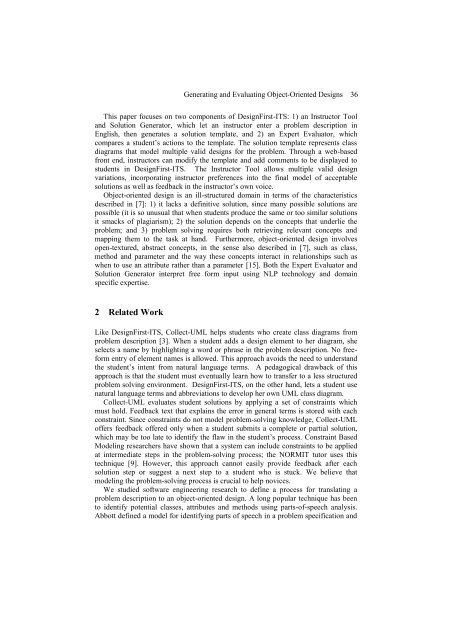Intelligent Tutoring Systems for Ill-Defined Domains - Philippe ...
Intelligent Tutoring Systems for Ill-Defined Domains - Philippe ...
Intelligent Tutoring Systems for Ill-Defined Domains - Philippe ...
Create successful ePaper yourself
Turn your PDF publications into a flip-book with our unique Google optimized e-Paper software.
This paper focuses on two components of DesignFirst-ITS: 1) an Instructor Tool<br />
and Solution Generator, which let an instructor enter a problem description in<br />
English, then generates a solution template, and 2) an Expert Evaluator, which<br />
compares a student’s actions to the template. The solution template represents class<br />
diagrams that model multiple valid designs <strong>for</strong> the problem. Through a web-based<br />
front end, instructors can modify the template and add comments to be displayed to<br />
students in DesignFirst-ITS. The Instructor Tool allows multiple valid design<br />
variations, incorporating instructor preferences into the final model of acceptable<br />
solutions as well as feedback in the instructor’s own voice.<br />
Object-oriented design is an ill-structured domain in terms of the characteristics<br />
described in [7]: 1) it lacks a definitive solution, since many possible solutions are<br />
possible (it is so unusual that when students produce the same or too similar solutions<br />
it smacks of plagiarism); 2) the solution depends on the concepts that underlie the<br />
problem; and 3) problem solving requires both retrieving relevant concepts and<br />
mapping them to the task at hand. Furthermore, object-oriented design involves<br />
open-textured, abstract concepts, in the sense also described in [7], such as class,<br />
method and parameter and the way these concepts interact in relationships such as<br />
when to use an attribute rather than a parameter [15]. Both the Expert Evaluator and<br />
Solution Generator interpret free <strong>for</strong>m input using NLP technology and domain<br />
specific expertise.<br />
2 Related Work<br />
Generating and Evaluating Object-Oriented Designs 36<br />
Like DesignFirst-ITS, Collect-UML helps students who create class diagrams from<br />
problem description [3]. When a student adds a design element to her diagram, she<br />
selects a name by highlighting a word or phrase in the problem description. No free<strong>for</strong>m<br />
entry of element names is allowed. This approach avoids the need to understand<br />
the student’s intent from natural language terms. A pedagogical drawback of this<br />
approach is that the student must eventually learn how to transfer to a less structured<br />
problem solving environment. DesignFirst-ITS, on the other hand, lets a student use<br />
natural language terms and abbreviations to develop her own UML class diagram.<br />
Collect-UML evaluates student solutions by applying a set of constraints which<br />
must hold. Feedback text that explains the error in general terms is stored with each<br />
constraint. Since constraints do not model problem-solving knowledge, Collect-UML<br />
offers feedback offered only when a student submits a complete or partial solution,<br />
which may be too late to identify the flaw in the student’s process. Constraint Based<br />
Modeling researchers have shown that a system can include constraints to be applied<br />
at intermediate steps in the problem-solving process; the NORMIT tutor uses this<br />
technique [9]. However, this approach cannot easily provide feedback after each<br />
solution step or suggest a next step to a student who is stuck. We believe that<br />
modeling the problem-solving process is crucial to help novices.<br />
We studied software engineering research to define a process <strong>for</strong> translating a<br />
problem description to an object-oriented design. A long popular technique has been<br />
to identify potential classes, attributes and methods using parts-of-speech analysis.<br />
Abbott defined a model <strong>for</strong> identifying parts of speech in a problem specification and


